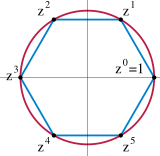In algebra, a cyclic group or monogenous group is a group that is generated by a single element.[1] That is, it consists of a set of elements with a single invertible associative operation, and it contains an element g such that every other element of the group may be obtained by repeatedly applying the group operation or its inverse to g. Each element can be written as a power of g in multiplicative notation, or as a multiple of g in additive notation. This element g is called agenerator of the group.[1]
Every infinite cyclic group is isomorphic to the additive group of Z, the integers. Every finite cyclic group of order n is isomorphic to the additive group of Z/nZ, the integers modulo n. Every cyclic group is an abelian group (meaning that its group operation is commutative), and every finitely generated abelian group is a direct product of cyclic groups
| p1, (*∞∞) | p11g, (22∞) |
|---|---|
 |  |
| Two frieze groups are isomorphic to Z. With one generator, p1 has translations and p11g has glide reflections. | |
A group G is called cyclic if there exists an element g in G such thatG = ⟨g⟩ = { gn | n is an integer }. Since any group generated by an element in a group is a subgroup of that group, showing that the only subgroup of a group G that contains g is Gitself suffices to show that G is cyclic.
For example, if G = { g0, g1, g2, g3, g4, g5 } is a group of order 6, then g6 = g0, and G is cyclic. In fact, G is essentially the same as (that is, isomorphic to) the set { 0, 1, 2, 3, 4, 5 }with addition modulo 6. For example, 1 + 2 ≡ 3 (mod 6) corresponds to g1 · g2 = g3, and2 + 5 ≡ 1 (mod 6) corresponds to g2 · g5 = g7 = g1, and so on. One can use the isomorphism χ defined by χ(gi) = i.
The name "cyclic" may be misleading:[2] it is possible to generate infinitely many elements and not form any literal cycles; that is, every gn is distinct. (It can be thought of as having one infinitely long cycle.) A group generated in this way (for example, the first frieze group, p1) is called an infinite cyclic group, and is isomorphic to the additive group of theintegers, (Z, +).
Nicolas Bourbaki, who was the French mathematicians group, called a cyclic group as monogenous group,[note 1] and defined a finite monogenous group as a cyclic group,[note 1] then, Bourbaki avoided the term infinite cyclic group


No comments:
Post a Comment